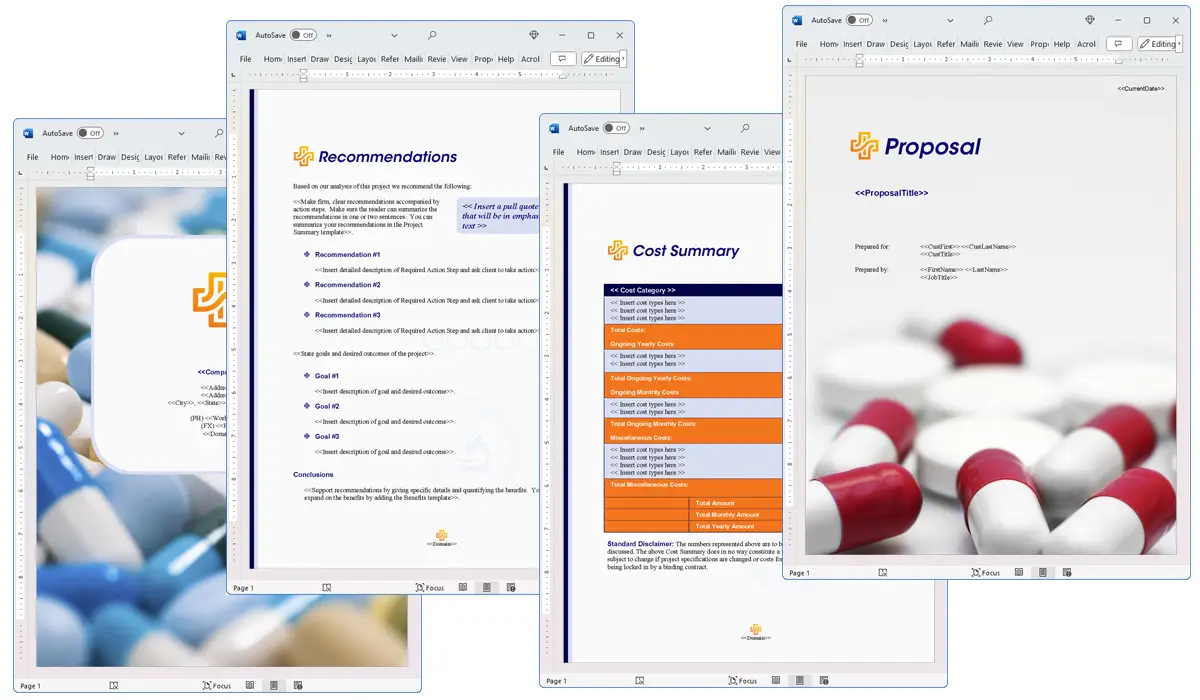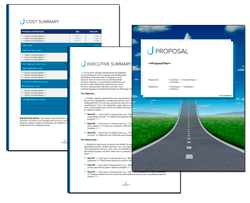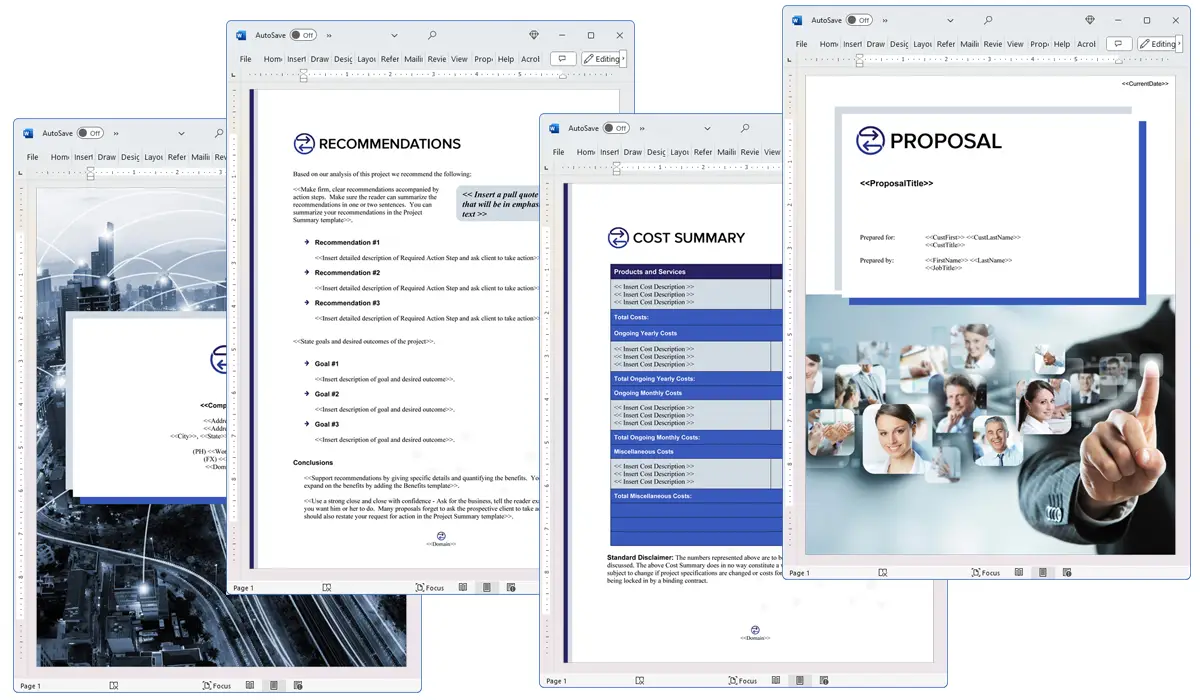What is the Byproducts chapter used for?
Proposal Kit Professional Bundle adds more design themes, all six Contract Packs,
a project management library, and Expert Edition software.

Illustration of Proposal Pack Healthcare #5
We include this Byproducts chapter template in every Proposal Pack, along with thousands more. You assemble this chapter with others in various combinations to create custom-tailored business proposals, plans, reports, and other documents. Proposal Packs apply custom visual designs to the templates, giving the final documents a consistent professional finish.
 DOWNLOADABLE, ONE-TIME COST, NO SUBSCRIPTION FEES
DOWNLOADABLE, ONE-TIME COST, NO SUBSCRIPTION FEES
Overview of the Byproducts Chapter
The Byproducts chapter is a specialized component designed for inclusion in business proposal documents. This chapter addresses how businesses can manage and use byproducts generated during their manufacturing, production, or operational processes. By articulating strategies for byproduct management, this chapter helps businesses demonstrate sustainability and efficiency in their proposal submissions. It is particularly vital in detailing how leftover materials from business operations can be repurposed or safely disposed of, which can enhance a company's environmental and economic performance.
How is the Byproducts Chapter Used?
In a business proposal, the Byproducts chapter is used to outline the approach a company takes towards the byproducts produced from their processes. This could be in response to a request for proposal (RFP) that requires detailed information on environmental impact and sustainability practices, or as part of a proactive pitch to improve a company's waste management system. The inclusion of this chapter helps companies showcase their commitment to environmental stewardship and resource efficiency, which are increasingly important factors in today's business environment.
What is Included in the Byproducts Chapter?
Typically, the Byproducts chapter includes:
- A detailed description of the types of byproducts generated by the processes used by the business or its clients.
- The current methods employed for handling these byproducts, including any recycling, repurposing, or disposal procedures.
- Proposals for new or improved methods of byproduct management, which may include innovative recycling techniques or partnerships with other companies for resource sharing.
- An assessment of the environmental impact of current and proposed byproduct management methods.
- Financial implications and potential benefits of improved byproduct management, providing a business case for any suggested changes.
Use Case Examples for the Byproducts Chapter
The Byproducts chapter can be adapted for various industry-specific proposals, including:
- Automation: Proposing systems that automatically segregate byproducts for recycling in a manufacturing plant.
- Manufacturing: Outlining techniques for reusing scrap metal in production cycles.
- Fabrication: Describing the handling of excess materials from cutting and shaping processes.
- Energy: Discussing the capture and repurposing of side products from energy production, like ash from coal plants.
- Resources and Mining: Proposing methods for managing tailings and other mining residues.
- Farming and Agriculture: Exploring the use of agricultural waste for creating biofuels or fertilizers.
- Ranching: Detailing strategies for handling animal byproducts in an environmentally friendly manner.
- Physical Items: Suggesting ways to repurpose defective items returned by customers or unsold goods.
Key Takeaways
- The Byproducts chapter is crucial for detailing how businesses address waste and byproducts in their operations.
- It assists companies in demonstrating their commitment to environmental sustainability and efficient resource use.
- This chapter is and can be tailored to different industries, reflecting specific byproduct challenges and solutions.
- Including this chapter in proposals can significantly enhance a company's competitive edge, especially in sectors where environmental impact is an important consideration.
- Effective management of byproducts not only aids in regulatory compliance but also opens up new opportunities for cost savings and revenue generation from recycled materials.

Illustration of Proposal Pack Classic #21
 What Our Clients Say
What Our Clients SayI have used different proposal softwares including BusinessPro and others but I find Proposal Kit to be user friendly and easily adaptable to different situations. One does not need to sit for hours of training before using Proposal Kit. Just watch the video for few minutes and you will be ready to use it."
Founder, RICCE
 4.7 stars, based on 848 reviews
4.7 stars, based on 848 reviewsRelated Chapters
Document Layouts Using the Byproducts Chapter

The Byproducts chapter and other chapters are integrated into a Word document as illustrated here in the Proposal Pack Communication #4 design theme. There are hundreds of design themes available, and every design theme includes the Byproducts chapter template.
A proper business proposal will include multiple chapters. This chapter is just one of many you can build into your proposal. We include the complete fill-in-the-blank template in our Proposal Pack template collections. We also include a library of sample proposals illustrating how companies in different industries, both large and small, have written proposals using our Proposal Packs. This template will show you how to write the Byproducts.
We include a chapter library for you to build from based on your needs. All proposals are different and have different needs and goals. Pick the chapters from our collection and organize them as needed for your proposal.
Using the Proposal Pack template library, you can create any business proposal, report, study, plan, or document.
The Wizard software includes an AI Writer, which will write the content of this and any other chapter of your document. Use the AI Writer to do the heavy lifting, writing the first draft of your proposal or business document in minutes.
 Ian Lauder has been helping businesses write their proposals and contracts for two decades. Ian is the owner and founder of Proposal Kit, one of the original sources of business proposal and contract software products started in 1997.
Ian Lauder has been helping businesses write their proposals and contracts for two decades. Ian is the owner and founder of Proposal Kit, one of the original sources of business proposal and contract software products started in 1997.By Ian Lauder
 Published by Proposal Kit, Inc.
Published by Proposal Kit, Inc.


 Cart
Cart
 Facebook
Facebook YouTube
YouTube Bluesky
Bluesky Search Site
Search Site